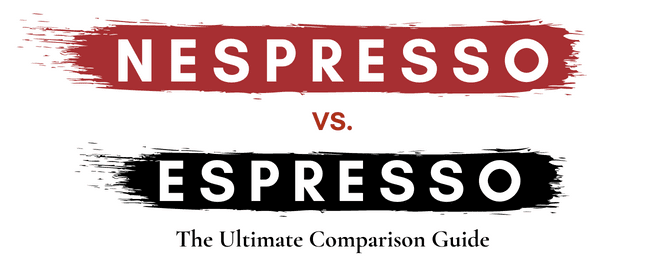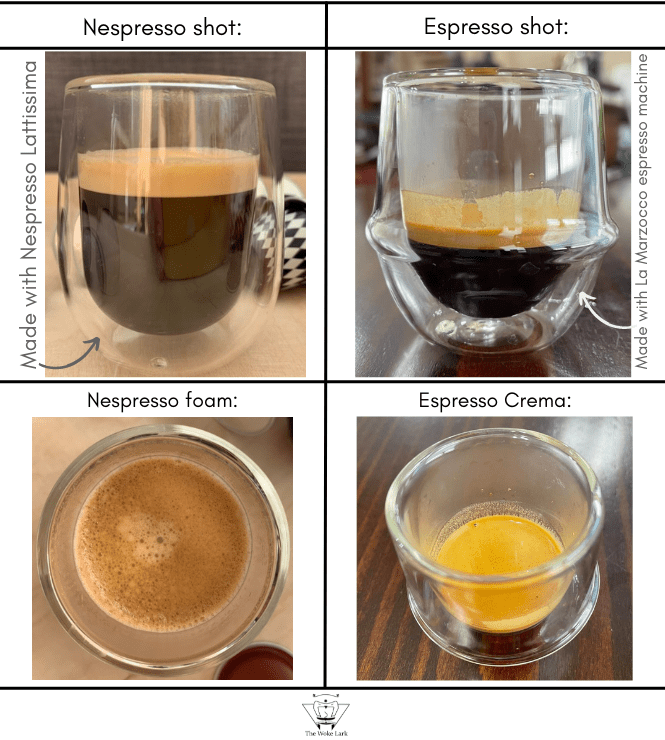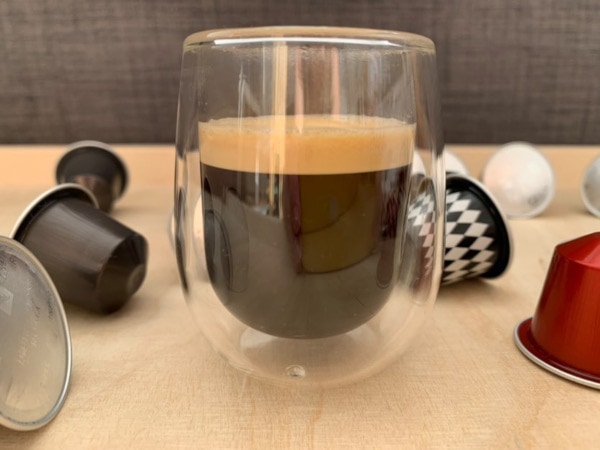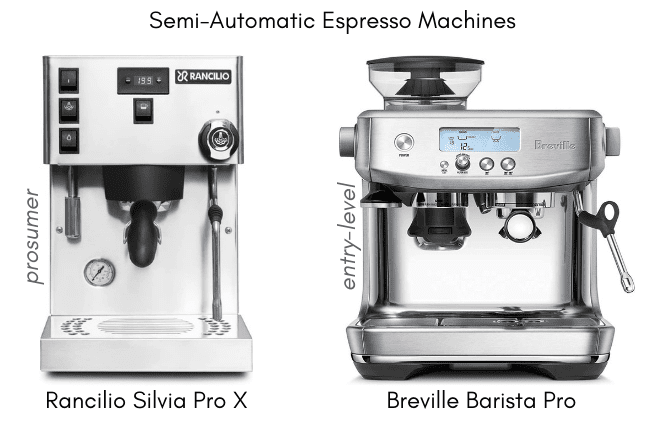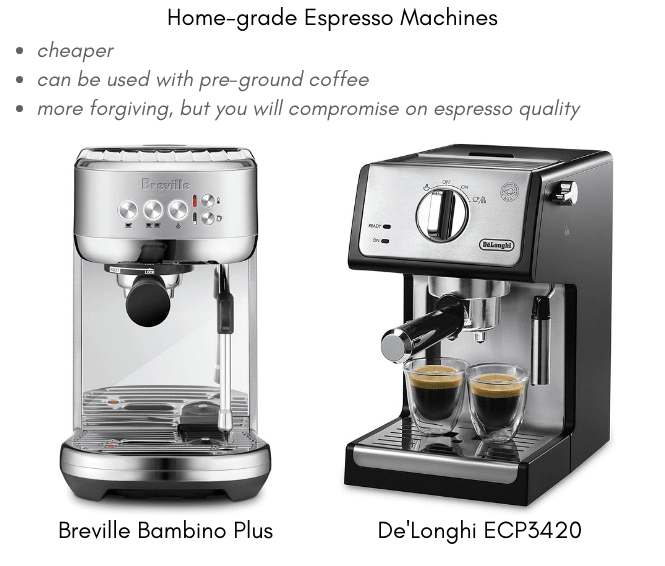Once you figure out what sets different coffee makers apart, it’s easy to choose the one that matches your taste and needs best.
That’s why I decided to make a Nespresso vs. espresso comparison guide and highlight the differences between these popular types of coffee machines.
And if you can’t – what are the differences between the drinks these machines produce?
Is it the taste, the mouthfeel, or the crema? Or it’s the strength, intensity, and caffeine content?
Are Nespresso Vertuo and Original coffee makers better than a cheap espresso machine?
Furthermore – could you actually pull a true espresso shot with your pod coffee maker? And if so, why is the cost of prosumer semi-automatic espresso machines significantly higher than the price of Nespresso models?
As you see there’s a lot to unravel, so let’s dive in!
Nespresso coffee vs. Real Espresso: Drinks Comparison
To explain whether you can make real espresso with a Nespresso machine, we first need to clarify what espresso is in its essence.
By definition, espresso is a specific beverage with Italian origins that is made by running hot water (190°F – 201°F / 88° C – 96° C) under pressure (9 bars) through a puck of finely ground coffee beans.
It’s traditionally made with 7 grams to 8 grams of ground coffee, with an extraction time of 22 to 28 seconds.
This specific brewing method yields 25 ml. to 30 ml. (1 fl. oz.) of concentrated coffee beverage.

If prepared according to the SCA standards, a real espresso would have a nice crema layer on its surface.
Espresso crema is made of CO2 microbubles that are released out of the coffee grounds during extraction.
The coffee proteins, oils, and fats attach to these microbubles, which creates a creamy-textured layer that sits on top of the espresso.
If we are to be precise, the only way to make a true espresso is by using an espresso machine with a non-pressurized portafilter.
Furthermore, it’s essential to point out that in order to achieve the desired extraction, we need to use very finely ground coffee that is tamped properly.
Because of the technology Nespresso machines use and the way they work, the beverage they produce differs from a classic espresso.
So here’s Nespresso coffee vs. real espresso comparison:
Nespresso coffee isn’t as intense and concentrated compared to real espresso.
Nespresso machines are capable of producing rich beverages with a balanced taste. Nevertheless, Nespresso drinks are weaker in terms of flavor intensity compared to an espresso made with a classic espresso machine.
Nespresso shots are with a thinner mouthfeel compared to espresso shots.
Furthermore, Nespresso machines aren’t capable of producing genuine espresso crema.
On the surface of your Nespresso beverage, you will get a thick foam layer that’s airier compared to the creamy layer of emulsified CO2 microbubbles that sits on top of a real espresso.
Espresso crema adds richness to the flavor of a shot and gives it a longer aftertaste. Nespresso foam improves flavor perception but has a lesser impact on the drink’s taste.
Still, it’s important to note that Nespresso’s espresso, ristretto, and lungo shots are pretty similar, and sometimes even better than those, pulled from cheap home-grade espresso machines.
The latter are targeted for people who don’t want to put much effort into their coffee-making ritual.
Cheap espresso machines use pressurized portafilters that allow for the use of pre-ground store-bought coffee.
They don’t require much precision when it comes to grind size, dose, distribution, and tamping.
The coffee such machines produce doesn’t have a crema layer. Instead, they have a foam layer that’s pretty similar to the one you’ll get on the surface of a shot that’s made with a Nespresso machine.
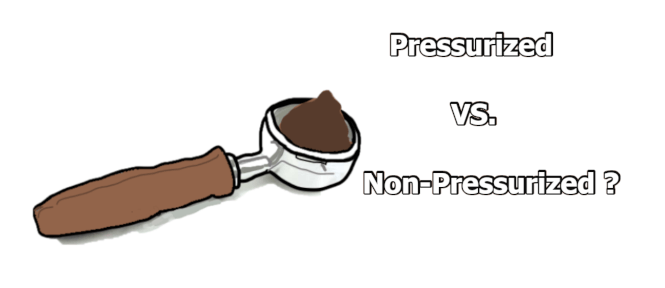
Here you can see a comparison chart that shows the basic dissimilarities between nespresso coffee, real espresso, and a shot, that’s pulled from a cheap espresso machine:
Overall, when it comes to taste and mouthfeel, you will notice a difference between a cup of Nespresso coffee and a shot of real espresso, made by a barista in a coffee shop or a cafè. You need to be aware of that in advance to avoid disappointment.
But let’s say you perform a blind test between a Nespresso shot and a shot pulled from a cheap espresso machine. You will find these drinks quite similar. Furthermore, you may even enjoy the Nespresso cup better. But more on that later.
Comparing the machines: How they work, Ease of Use, Price & More
To better understand the differences between Nespresso coffee makers versus espresso machines, we need to take a closer look at how they work.
The comparison between the basics of their function will help you figure out which machine matches your needs better.
Nespresso Machines and How They Work: The Basics
Nespresso machines are pod coffee makers that work in combination with Nespresso capsules. They are ideal for those who want to make delicious coffee quickly, effortlessly, and without creating a mess.
There are two types of Nespresso machines: Original and Vertuo.
- OriginalLine Nespresso machines use pressure-based extraction. The machine punctures the coffee capsule and forces hot water inside of it until the needed pressure is reached. Then the bottom of the capsule bursts from the applied pressure, and the coffee starts pouring into your cup.
OriginalLine Nespresso machines work with ristretto (0.85 oz./25 ml.), espresso (1.35 oz./40 ml.), and lungo (3.7 oz./110 ml.) OriginalLine capsules.
Because of the pressure system, Original makers produce coffee with a nice foam layer that consumers like.
A shot of espresso, made with Nespresso Lattissima OriginalLine Coffee Maker.
Some Original Nespresso coffee makers have integrated milk frothers that are targeted for those who want to easily make latte and cappuccino drinks at home. - VertuoLine Nespresso machines use a spinning (“centrifusion”) system during extraction. The hot water saturates the grounds, and the capsule gets spun at 7000 rpm. The agitation created by the spinning of the pod has a positive effect on extraction and results in a flavorful cup that’s topped off with a layer of coffee foam.
Vertuo capsules have a barcode that’s printed on their undersides.
The machine has software that reads the barcode and creates optimal brewing conditions for the specific pod you’ve inserted. This improves extraction and results in a better-tasting cup of coffee.
It’s worth noting that you can use Vertuo coffee makers to prepare larger servings. Apart from espresso, there are gran lungo (5 oz./150 ml) and mug (7.77 oz./ 230 ml) Vertuo pods. Furthermore, some models accept carafe capsules that you can use to make 18 oz. (530 ml.) of coffee at once.
You can check out my guide on the best Nespresso machines, to see a comparison between the characteristics of the top models.
Espresso Machines & How They Work
Fundamentally, espresso machines work by forcing hot water under pressure (~ 9 bars) through a puck of finely ground and tamped coffee beans.
The coffee puck provides the necessary resistance to the hot water and allows for the pressure to build up.
This type of extraction results in a concentrated coffee beverage with intense flavor, high caffeine concentration, and a crema layer that differs from the foam you’d get from a Nespresso machine.
To pull an espresso shot according to the SCA standards you need a high-quality grinder that’s capable of producing espresso-fine grind.
Furthermore, you have to make sure that the grounds are evenly distributed inside the filter basket and tamp them properly.
Using an espresso machine requires much more technique and precision compared to using a Nespresso machine.
Especially if you want to end up with a real espresso, comparable to the one you’d get from a nice cafè.
Furthermore, if you use an espresso machine, you will be able to make recipe adjustments according to the specific type of coffee beans you use. Tweaking the grind size, the coffee dose, the brew temperature, or the amount of water that passes through the grounds can make a great difference in the extraction quality.
Such flexibility isn’t possible with Nespresso machines. So if you want to explore different specialty coffees and get the best flavors out of the ground beans, go for a semi-automatic espresso coffee maker.
Most espresso machines have steam wands for milk that you can use to make coffee drinks, such as lattes, cappuccinos, and flat whites. But there’s a learning curve to achieving the ideal milk texture as well.
Nespresso vs. Espresso machines: Price
Passionate espresso lovers would gladly invest in a prosumer espresso machine such as the costly Rancilio Silvia Pro X. They’d also buy a high-quality grinder, such as the Rancilio Rocky, as it’s an essential equipment piece for making a true espresso.
It’s also common for espresso aficionados to get a machine such as the Breville Barista Pro that has an integrated grinder.
It’s the less expensive alternative to other prosumer espresso makers, but its price is still significantly higher than most Nespresso models.
With that being said, there are cheap home-grade espresso machines that have made it easier for the consumer to pull decent shots without putting in that much effort.
Said machines use pressure-based extraction as well, but have double-walled (pressurized) portafilters that are quite forgiving in terms of distribution and tamping technique, as well as grind quality.
To make a decent shot with such home-grade espresso makers, you can use pre-ground coffee from the supermarket, and pay much less attention to the brewing variables.
Such machines are the Breville Bambino Plus, or the affordable De’Longhi ECP3420.
With them, you can prepare coffee that is quite similar in terms of flavor intensity, strength, and foam layer compared to the cup you’d get from a Nespresso machine.
Nevertheless, the process of pulling a shot is a bit messier and requires a bit more effort compared to using a pod coffee maker. So if you’re looking for the quickest and most hassle-free way to brew a cup, a Nespresso machine is the better option.
On the other hand, using an espresso instead of a Nespresso machine has its advantages.
One of them is that you will pay a lower price per cup of coffee.
Nespresso capsules’ price varies within the range of $0.75 to $2.00 per pod. In comparison, pulling a shot with an espresso machine would cost around 20 cents.
Even if you want to use higher-grade specialty coffee beans, the price per cup of coffee made with an espresso machine would still be lower compared to the cost per Nespresso pod.
So here’s Nespresso vs. Espresso machines price comparison overview:
Nespresso coffee makers are cheaper than prosumer espresso machines that are capable of producing a real espresso.
Furthermore, to pull espresso shots by the book, you need a high-quality grinder that requires an even bigger investment.
With that being said, the price per cup of Nespresso coffee is generally higher compared to a price of a cup of coffee that’s made with an espresso machine at home.
It’s also worth noting that you can get a cheap home-grade espresso machine that’s even more affordable than some Nespresso models. You can use such a machine to pull a shot that’s similar to Nespresso’s espresso in terms of taste, intensity, and mouthfeel.
Sustainability
Another one of the main advantages of using an espresso machine is that it’s a more sustainable and eco-friendly option compared to Nespresso coffee makers.
Even though there is a recycling program for Nespresso pods, the waste these capsules generate is still astonishing.
Furthermore, to recycle the pods you still need to put in a bit of extra effort and drop off your used capsules at one of Nespresso’s collecting points.
And not all Nespresso users are willing to do that.
If you decide to use an espresso machine instead, you will reduce the amount of waste you generate. After pulling a shot you’d only need to throw away the spent coffee grounds. Even better – you can compost them or reuse them for a different purpose.
Related Post: How to Reuse Coffee Grounds?
Author’s Note: If you wish to make espresso coffee drinks quickly and effortlessly, but you want to avoid the use of Nespresso pods because of the generated waste, you can get a super-automatic espresso machine, such as the De’Longhi Magnifica.
It has a built-in burr grinder, but you can also use it with pre-ground coffee.
It lets you pull a shot with zero prep with only one click.
You only need to fill in the water tank and the coffee chamber.
With that being said, such superauto espresso machines produce shots of lower quality compared to semi-automatic/prosumer espresso machines.
Caffeine content comparison
Because of the way it’s made, espresso is a type of coffee drink that has the highest concentration of caffeine per fluid ounce.
An espresso shot (1 fl. oz./30 ml.) usually contains around 70 to 80 mg. of caffeine. Nevertheless, the amount varies depending on several variables (the type of coffee beans, the water temperature, the roast profile, etc.).
Related Post: Which coffee has the most caffeine?
Nespresso pods’ caffeine content varies within a wider range, depending on the type of pod you use.
Original capsules generally contain between 60 and 80 milligrams of caffeine, and Vertuo espresso pods contain 100 milligrams of caffeine on average. Nevertheless, VertuoLine 7.77 oz (230 ml.) coffee contains between 150 mg. to 200 mg. per serving.
To find out more about the caffeine content of different Nespresso capsules, check out this post.
Overall, I’d say that in terms of caffeine content per fluid ounce, the difference between a real espresso shot and a cup of Nespresso coffee is negligible. Both alternatives are capable of producing a cup that will give you a strong caffeine kick.
Related Post: Why doesn’t coffee wake me up?
The Verdict
Once you know the differences between Nespresso vs. espresso drinks and machines it becomes easy for you to choose which coffee maker matches your personal needs better. As with many things in life, it all comes down to personal preference.
So here’s a summary of the takeaways from this espresso versus Nespresso comparison guide:
- If you want to make a real espresso with rich flavor, high intensity and texture, and a nice crema layer on top, get a prosumer espresso machine or a lever machine. If you decide to do so, you’d also need to invest in a high-quality espresso grinder. Keep in mind that pulling high-quality shots takes a bit more time and technique. But it’s totally worth it (if you ask me, of course).
- If you want to make a delicious cup of coffee quickly and effortlessly, and you don’t insist on being able to make espresso of the highest quality at home, get a Nespresso machine.
- If you don’t want to invest a lot of money in a coffee maker, but you want to make similar to Nespresso’s coffee beverages, get a cheaper home-grade espresso machine with a pressurized portafilter. It doesn’t require that much technique and you can use pre-ground coffee from the supermarket with it. This option is also better for those who don’t want to use single-use capsules because of the waste they generate.
- If you want to make more eco-friendly and sustainable purchases, get an espresso machine instead of Nespresso. You will spend a bit more time preparing a cup, but you won’t support the pod coffee industry that generates a lot of waste.
- If you insist on getting a coffee maker that lets you brew a cup with only one click, but you don’t want to use pods, get a super-automatic espresso machine. Just keep in mind that you won’t get the best espresso out of such a machine. It will be weaker compared to a high-quality espresso shot pulled according to the defined espresso standards.
I hope that you found this post helpful and that you’ve learned something new. Leave me a comment below if you have further questions, or simply share your experience. I’d love to find out which coffee machine did you choose and why?

